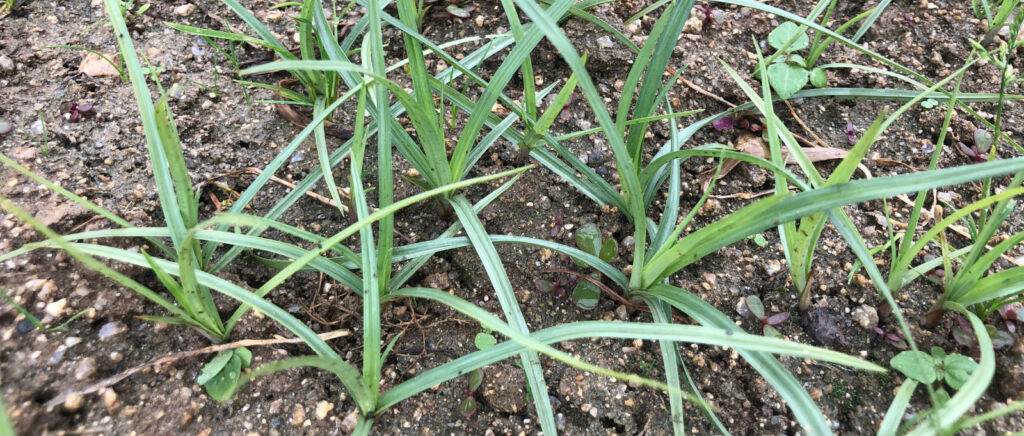How to plant Zucchini.
Have we ever considered planting zucchini in our garden, or as a large-scale project? Here we have developed a guide that will take us by the hand and step by step, to achieve an abundant, healthy and chemical-free harvest.
We will learn to select the perfect place for our planting, we will prepare the soil properly, we will study all the details required before, during and after cultivation, maximizing the yield and quality of the harvest.
Additionally, we will explore sustainable techniques such as using biodegradable paper mulch to protect our crops while respecting the environment we so need.
Why plant zucchini?

- This herbaceous plant is fast growing, guaranteeing us a constant supply of fresh crops, with a high level of productivity and rich in nutrients, free of pesticides and its delicious flavor can be used in a wide variety of dishes.
- In addition, zucchini easily adapt to various temperatures, from tropical to temperate climates, which is why they are highly appreciated and valuable for agriculture and world cuisine.
- Planting zucchini in family gardens or in large-scale plantings provides us with a natural source of vitamins A, C and K, and contains essential minerals such as potassium and magnesium.
- Its low calorie content makes it an ideal ingredient for those looking for a healthy diet.
- In this space we will learn to master the correct techniques to plant zucchini successfully, we will maximize the yield of our crop and obtain abundant harvests throughout the seasons.
Link: https://helvia.uco.es/handle/10396/13788
Characteristics and economic, agricultural and sustainable importance that we must consider when planting zucchini.
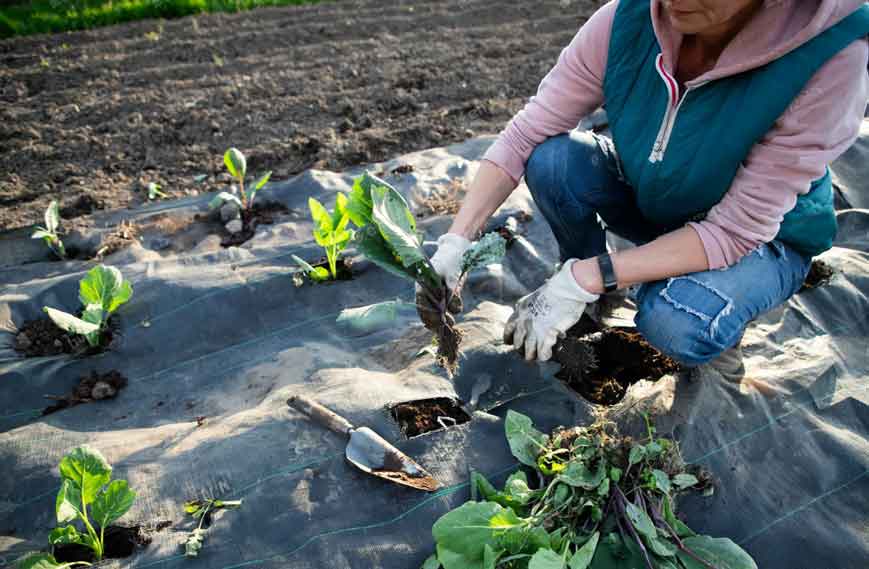
Let’s get acquainted with these wonderful vegetables. Zucchini belong to the cucurbitaceae family.
- This is a botanical group of great economic and agricultural importance, in which there are around 965 species distributed in more than 90 genera, many of which are essential in human nutrition and agricultural cultivation throughout the world.
- The best known are zucchini, pumpkin, cucumber, melon, watermelon and chayote.
When we decide to plant zucchini we must have enough information to enter the world of these delicious vegetables, and we will obtain an excellent introduction to the wonderful experience of gardening:
- They are mainly fast-growing herbaceous plants, rich in water, low in calories and very versatile in the kitchen.
- They tend to be climbers or crawlers, thanks to the presence of tendrils that help them support themselves.
- Their stems are usually angular and often have trichomes (hairs) that give them a rough texture.
- Its leaves are large, which makes them effective in capturing the sunlight that plants need and thus promote vigorous development.
- Zucchini produce yellow or orange flowers that are very attractive to insects, especially bees, and this promotes biodiversity in our garden.
- Furthermore, in this key step, the pollination process will be crucial for the formation of fruits.
- Each fruit has a fleshy structure with a hardened shell, and like the seeds, they are rich in water, vitamins A and C, antioxidants, fiber and minerals such as potassium and magnesium.
- The seeds are numerous, elongated and flat. They are usually edible and highly nutritious.
- It is very important that we know that by planting zucchini after a different planting than the one we have harvested, we will help prevent not only diseases but we will also enrich the soil, thanks to the ability of these herbaceous plants to absorb the diversity of nutrients that they contain. they remain in the substrate.
- Economic importance? Planting zucchini gives us savings in the consumption of vegetables rich in nutrients, low in calories and adaptable to our kitchens due to their delicate flavor, both in savory and sweet dishes.
The success of planting zucchini begins with well-structured key steps.
This activity may seem simple; However, for our plants to develop healthy, robust and productive, we need to organize all the steps and control all the variables or unforeseen events that may appear in this process.
- Select the correct place to plant zucchini.
- Sowing the seeds; study the specific conditions of our soil, and methods to follow that are appropriate to the climate we inhabit.
- Efficient and necessary irrigation that guarantees healthy and robust growth.
- Implement the use of biodegradable paper mulching as a sustainable and environmentally friendly practice.
- Average time and tips for a continuous and abundant zucchini harvest.
- Tips to optimize the storage of zucchini after harvest.
- Shelf life of zucchini depending on the storage method we use.
Select the right place to plant zucchini.
This is the first key step to ensure that our plants develop healthy and produce high-quality fruits, as zucchini require several conditions to grow successfully.
- The area in which we are going to plant zucchini must receive between 6 and 8 hours a day of sunlight, its vital energy. We must take into account that zucchini thrive and improve the quality of their fruits under a good dose of sun.
- Now, if our garden is located in areas with a lot of wind or fluctuating temperatures, it is advisable to plant in protected spaces such as a greenhouse, as the wind will damage the leaves and affect the pollination process.
- On the other hand, we need a fertile soil with a well-prepared substrate, with good drainage and rich in organic matter.
- The correct pH that we are going to control will be between 6.0 and 7.5, to ensure an adequate balance of nutrients.
- If our soil is too clayey or sandy, or prone to waterlogging and water retention, or on the contrary, poor in water retention and drainage, we must improve it by adding compost material or well-decomposed and loose manure.
- If we follow these steps in detail, they will help us promote the optimal growth and development of our crop, and we also prevent the appearance of diseases and irreparable damage to the roots.
- An excellent solution to avoid headaches when planting zucchini will be to use sustainable techniques such as biodegradable paper mulching; This material has the necessary characteristics to preserve and favor the entire process of both the substrate and the crop, in unbeatable and safe conditions.
- It is not recommended that we go to plant zucchini in the same soil in which we have already grown the last harvest of the same family (pumpkin, cucumber, melon, watermelon, chayote).
- Although it is true that these herbaceous plants have the capacity to absorb the diversity of nutrients that remain in the substrate, to avoid the appearance of diseases typical of this species it is preferable to wait approximately 3 years, and we also make room for these nutrients are adequately recovered.
Preparing the soil for planting zucchini:
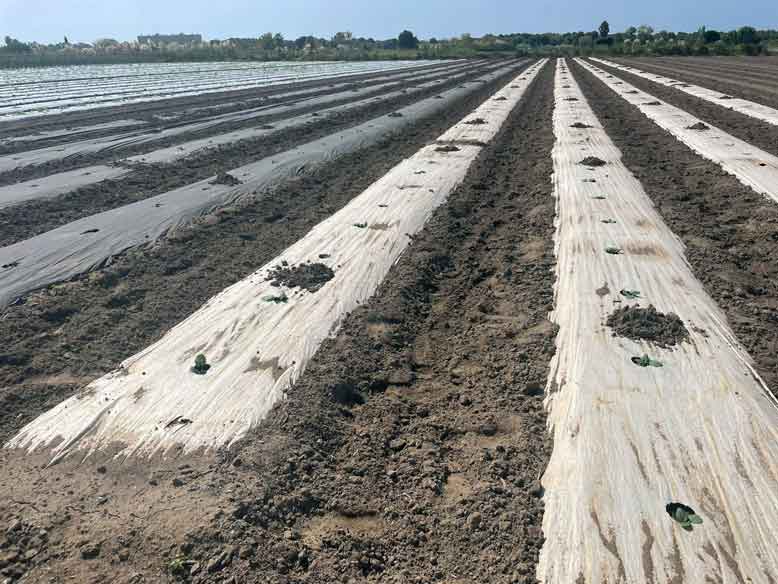
- Step 1: We must clean and clear the land, eliminating traces of weeds and any residue that could be harmful to our crop. This way we prevent competition for nutrients from developing when other plants that have remained dormant develop, while at the same time the soil can weaken and be prone to the appearance of pests.
- Step 2: We are going to aerate the land with a hoe, motocultor or other suitable tool for this, to promote air circulation and good drainage of water to the roots.
- Step 3: To enrich and complement the quality of the soil with essential components such as nitrogen, phosphorus and potassium, we will add compost, worm castings or well-decomposed and loose manure.
Before planting zucchini, let’s learn about several important details that we should consider.
Another key step to be successful in our project of planting zucchini is the selection of seeds that adapt to the characteristics of the land we have, our climatic conditions and our culinary preferences, as we will see below.
- Let’s select seeds from reliable suppliers, and only those that adapt to our climate and temperature, to the conditions of the soil in which we are going to plant zucchini, and without failing to review all the specifications and requirements that appear on the package.
- If we wish to grow with sustainable and environmentally friendly methods, we will select organic seeds and make excellent use of biodegradable paper mulch, for optimal results.
Let’s analyze the area we have for our planting:
Within the variety of seeds we have compact zucchini, which are suitable for urban gardens, and if we have vertical space, there are climbing varieties that adapt perfectly if our space is smaller, such as the Climbing Zucchini.
Let’s take a tour of the different species that we can use in our kitchens.
Dark green zucchini:
- Featured varieties: Black Beauty, Zucchini Green Bush.
- Characteristics: elongated dark green fruits with shiny skin, fast growing and high productivity, suitable for temperate and warm climates.
- Uses: thanks to their firm pulp, they are perfect for stir-fries, stews and fillings.
Light green zucchini:
- Featured varieties: Clarita, Gray Zucchini.
- Characteristics: light green skin with darker veins or spots, mild flavor and tender texture, tolerant of hot and dry climates.
- Uses: ideal for roasting, frying or preparing as baby zucchini.
Yellow zucchini:
- Featured varieties: Golden Delight, Gold Rush.
- Characteristics: bright yellow skin, generally with a sweeter flavor and very visually attractive, fast growing and high yielding and suitable for warm and temperate climates.
- Uses: perfect for giving a touch of color to recipes such as fresh salads and pastas.
Round zucchini:
- Featured varieties: Tondo di Piacenza, Rondini.
- Characteristics: small, round fruits, with uniform or marbled green skin, compact and easy to handle and ideal for moderate climates.
- Uses: perfect for filling and baking due to its spherical shape.
Climbing zucchini:
- Featured varieties: Tromboncino, Cucuzza.
- Characteristics: Vigorous plants with a climbing growth habit, long, curved fruits with light green skin and suitable for vertical or small spaces, and thrive in warm and temperate climates, even when we should avoid exposing them to strong winds.
- Uses: ideal for stir-fries and stews, with a texture similar to tender pumpkin.
Disease resistant hybrid zucchini:
- Featured varieties: Defender F1, Partenon.
- Characteristics: Hybrid seeds designed to resist common diseases such as mildew, their fruits are of high quality and uniform size, and with continuous productivity even in adverse conditions.
- Uses: they are very versatile in our kitchen and adaptable to any recipe.
Varieties of White Zucchini:
Here we present this link that shows us in depth everything related to this beautiful species.
https://www.agrocabildo.org/publica/Publicaciones/otra_816_calabacines.pdf?utm_source=chatgpt.com
Sowing the seeds.
According to our requirements, that is, according to the climate and conditions of our land, we can plant zucchini in two main ways:
- Direct sowing is suitable in warm climates with constant temperatures and no chance of frost or frequent rain, from late spring to early summer.
- If this is our case, we can sow the seeds directly into the soil at a depth of 2 to 3 cm.
- It is advisable to maintain a distance of 60 and 90 cm between each plant, to ensure successful growth and proper air circulation.
- In addition, in this way we reduce the possibility of plants entering into competition with each other for light, water and nutrients.
- If, on the other hand, we live in cold climates, with a tendency to low temperatures or need short times to grow, it is ideal to plant zucchini indoors or in greenhouses, using germination trays or pots, and if necessary we will implement heating systems.
- In these cases we must control that our seedlings receive enough light and develop in a balanced temperature. If we observe that the climate becomes favorable (temperate to warm if possible), we can transfer the seedlings that have 2 and 3 leaves to the ground; We dug a hole, and carefully placed them, covering them lightly with earth.
- In temperate climates, we recommend starting sowing zucchini indoors, in seedbeds, and in late winter or early spring.
- We must periodically observe temperature changes, and when they are constant, we can transplant the seedlings outdoors.
Diseases and pests.
We must keep in mind that planting zucchini is not exempt from being affected by various diseases and the appearance of pests, which is why we are going to identify them and learn to implement effective strategies to control the appearance and spread in our crop.
Mildiu (Oidium spp. y Pseudoperonospora cubensis).
- The obvious symptoms will be the appearance of yellow spots on the leaves, or a whitish or gray coating on the upper part of the leaves, which will cause them to dry out and die.
- The causes that produce this disease are the high level of humidity and temperatures that range between 15° and 25° C.
- To prevent and control this, we must improve the ventilation of our crop and make adequate separation between each plant.
- To avoid all this, it is very important that the water irrigation is directly on the soil and not on the leaves of the plants.
- Organic fungicides based on sulfur or potassium bicarbonate are very effective, but we must remember that if we use biodegradable paper mulch from the beginning of planting, we can avoid this and other inconveniences during the development process of our zucchini.
Root rot (Pythium spp. y Phytophthora spp.)
- When plants lose their color and wilt, these are clear signs that the roots are blackened and soft.
- This is due to soils with inadequate drainage or excess irrigation, which is why, when planting zucchini, we must take all possible precautions and controls so that we can prevent this damage, which is irreparable.
- Measures to be taken such as treatments with beneficial microorganisms such as Trichoderma, avoiding water accumulation and controlling irrigation, will be effective; However, the use of biodegradable paper mulch will be of great help to maintain this control that is essential to achieve a successful crop in optimal conditions from start to finish.
Zucchini mosaic virus (Zucchini Yellow Mosaic Virus, ZYMV)
- Aphids (Aphididae) are very common insects in these crops, and they cause the appearance of irregular yellow patterns and malformations on the leaves, as well as defective and stained fruits.
- They appear in the form of colonies of small green, black or yellow insects on the shoots and undersides of the leaves, and show a sticky residue (honeydew) that can attract fungi.
- In these cases we must eliminate infected plants to avoid contamination to the rest, and implement varieties resistant to this virus, introducing natural enemies such as ladybugs or lacewings.
- Likewise, we can eliminate colonies using garlic extracts or potassium soap.
Anthracnose (Colletotrichum spp.)
- This is a plant disease caused by several fungi of the genus Colletotrichum, which affects not only zucchini, but a wide variety of plants, including fruit trees, vegetables, legumes and ornamental crops.
- It develops especially in warm climates (between 20 and 30 °C), and humid (greater than 85%), in conditions of stagnant water or prolonged rain, and produces sunken lesions on the fruits, and brown or black spots on both leaves and in stems, fruits and flowers.
- Anthracnose spreads quickly, compromising crop yield, and that is why we must remove and destroy the affected parts of the plants, and very importantly, rotate the crops continuously.
- One option to control this disease is to introduce beneficial microorganisms such as Trichoderma spp. which competes with the pathogenic fungus and inhibits it, and Bacillus subtilis which acts as a natural biocontrol agent.
Red spider (Tetranychus urticae)
It is a tiny red or orange-brown mite; It feeds on plant sap and is one of the most common and destructive pests in zucchini crops, especially in hot, dry climates.
- Although it is microscopic, its ability to reproduce quickly and form large colonies can cause serious damage in a short time, affecting both the development of the plant and the quality of the fruits.
- It develops especially in hot and dry climates with temperatures above 25 °C, as well as in areas with low humidity (less than 50%), or climates lacking prolonged rain, as water interferes with its reproductive activity, so it is recommended increase the level of humidity in sowing.
- Visible damage to zucchini is yellow or silvery spots on the upper surface of the leaves, known as “chlorosis, loss of color and dull appearance, with dry and curled leaves in advanced stages.
- The red spider produces fine cobwebs that cover the underside of the leaves and between the stems, making it difficult for the plant to breathe and absorb light.
- In these cases, the first step will be to remove and destroy the most affected leaves and stems to prevent spread, use vegetable oils or insecticides based on abamectin or sulfur, and if we choose to do biological control we will introduce natural enemies such as Phytoseiulus persimilis, a predatory mite specialized in red spiders, and Ladybugs and Lacewings, which feed on the eggs and larvae of these spiders.
Link: https://articulos.infojardin.com/huerto/cultivo-calabacin-calabacines.htm
Efficient and necessary irrigation for planting zucchini.
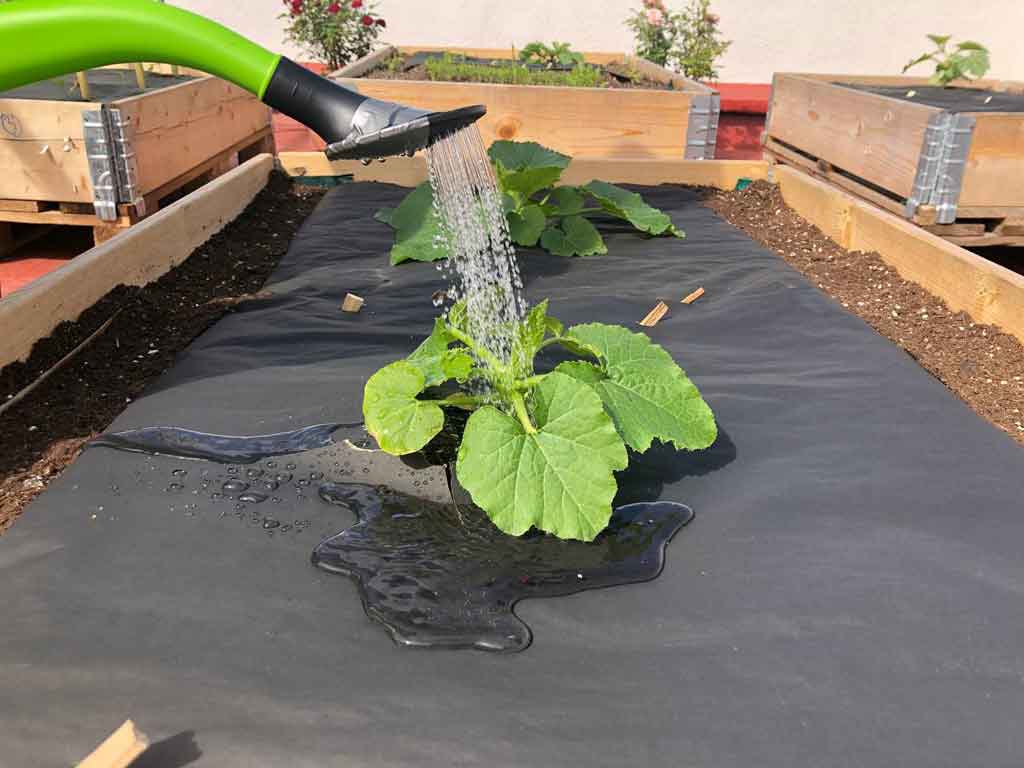
In this key step of our project, we must consider the irrigation capacity of water we have available, as zucchini require a regular supply. However, we must avoid excesses to protect the proper development and life of the roots.
- We recommend watering every 2 or 3 times a week for warm climates, as long as water retention is fluid and the plants’ needs require it.
- Let’s remember that we are always going to avoid flooding or accumulation of water in any area of the ground.
- On the other hand, we can implement drip irrigation, which is very effective for planting zucchini, as the water would reach the roots directly, reducing evaporation, keeping the foliage dry and, very importantly, we reduce and control water consumption.
Link: https://dialnet.unirioja.es/servlet/articulo?codigo=8213056
Link : https://www.mapa.gob.es/ministerio/pags/biblioteca/hojas/hd_2000_2105.pdf
Implement the use of biodegradable paper mulch to plant zucchini.
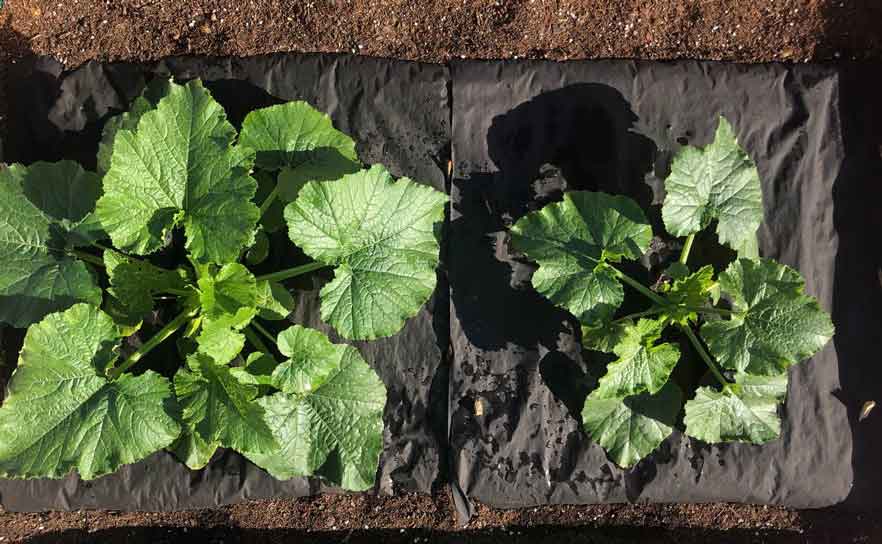
Mulching is a highly recommended innovative technique because this material helps us reduce costs, protects and maintains the cultivation process impeccable from the beginning to harvest, and due to its biodegradable structure it becomes a fertilizer rich in nutrients for the soil and our plants. next crops and we also contribute to the protection of the planet, since we do not generate plastic waste.
Furthermore, when we adopt the use of biodegradable paper mulch as a sustainable and environmentally friendly practice, we manage to maintain the necessary amount of moisture that the soil needs to maintain the balance of the planting, we control the appearance of weeds, diseases and pests, we promote the rapid and healthy development of roots, and we achieve an organic and abundant harvest of fresh and healthy fruits.

-
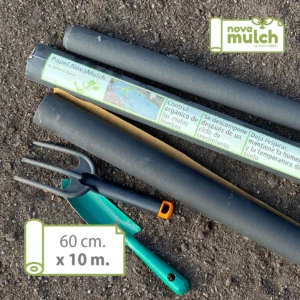 Novamulch paper 60 cm. x 10m.14,85 € IVA incluido
Novamulch paper 60 cm. x 10m.14,85 € IVA incluido -
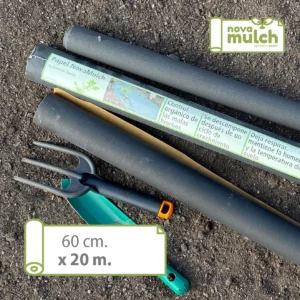 Novamulch paper 60 cm. x 20 m.21,89 € IVA incluido
Novamulch paper 60 cm. x 20 m.21,89 € IVA incluido -
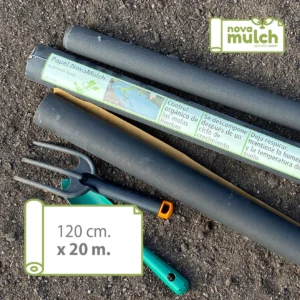 Novamulch paper 120 cm. x 20 m.41,63 € IVA incluido
Novamulch paper 120 cm. x 20 m.41,63 € IVA incluido -
 Novamulch Professional Paper 60 cm. x 300 m.47,10 € IVA incluido
Novamulch Professional Paper 60 cm. x 300 m.47,10 € IVA incluido -
 Novamulch Professional Paper 120 cm. x 300 m.94,21 € IVA incluido
Novamulch Professional Paper 120 cm. x 300 m.94,21 € IVA incluido -
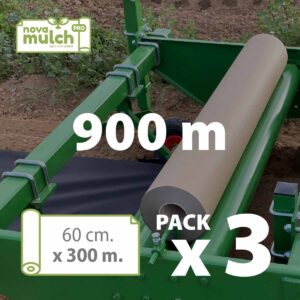 PACK of 3 rolls of Novamulch Professional paper 60 cm. x 300 m. (900 m)141,30 € IVA incluido
PACK of 3 rolls of Novamulch Professional paper 60 cm. x 300 m. (900 m)141,30 € IVA incluido -
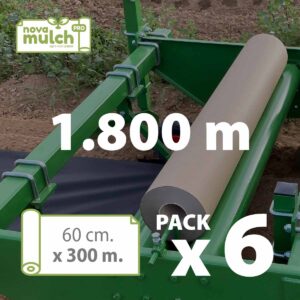 PACK of 6 rolls of Novamulch Professional paper 60 cm. x 300 m. (1.800 m)282,22 € IVA incluido
PACK of 6 rolls of Novamulch Professional paper 60 cm. x 300 m. (1.800 m)282,22 € IVA incluido -
 PACK of 3 rolls of Novamulch Professional paper 120 cm. x 300 m. (900 m)282,22 € IVA incluido
PACK of 3 rolls of Novamulch Professional paper 120 cm. x 300 m. (900 m)282,22 € IVA incluido -
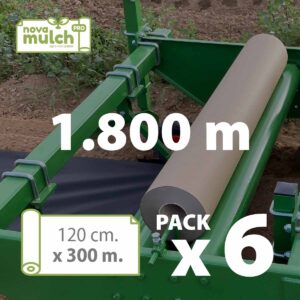 PACK of 6 rolls of Novamulch Professional paper 120 cm. x 300 m. (1.800 m)565,28 € IVA incluido
PACK of 6 rolls of Novamulch Professional paper 120 cm. x 300 m. (1.800 m)565,28 € IVA incluido
Average time for a continuous and abundant zucchini harvest.
The expected time to harvest our zucchini will be 45 and 60 days after planting. This is due to several factors:
- Some early zucchini varieties can be ready to harvest in 40 to 45 days, while others require up to 60 days.
- We must consider that varieties with smaller fruits can mature faster than those that produce larger fruits.
- Zucchini develop more easily in temperatures of 20° to 30°, with good sunlight and heat.
- In cooler climates, the ripening time will extend a few days longer.
- When we implement sustainable techniques such as paper mulching, as well as properly nourished soil and constant and measured irrigation, we will have the opportunity to shorten the development time in optimal conditions for our plants.
How do we know if the zucchini are ready to harvest.
The expected times serve as a good guide, however, it is advisable to observe our zucchini so that we can determine the appropriate and optimal time for harvesting. Here we show several key signs:
- Zucchini can be harvested when they reach a size between 15 and 20 cm long, and at this time they will have a tender texture and a sweeter flavor.
- If we prefer smaller fruits such as baby zucchini, we can harvest them when they reach a size between 10 and 15 cm.
- According to the variety we referred to above, we must take into account that the color of the fruit must be uniform, and the skin must be smooth, firm and without spots or cracks.
- The flowers that we see at the end of the fruits should begin to dry or fall, and then we will know that the zucchini are at the right time to be harvested.
- Finally, the perfect time to harvest will be when they feel firm to the touch but not too firm, since if the latter it means that they have overripe.
Observing the process of our cultivation is crucial not only to control the proper development of the fruits, but at harvest time we must take all possible precautions. If the fruits remain on the plants longer than expected, several problems will appear:
- The texture and flavor will change, as more mature zucchini will have a harder skin, less tender flesh, and will taste bland or bitter.
- The production of new fruits on the same plants will be affected, it will not be as abundant, and mature fruits with the ideal size will be vulnerable to diseases and insect attacks.
Tips for a continuous and abundant zucchini harvest.
- It is advisable to harvest the zucchini every 2 or 3 days because in this way we will stimulate the development of new fruits.
- Let’s use the right tools, such as a clean knife and pruning shears.
- When cutting each fruit, we must leave a small piece of stem attached to the plant, to help prevent possible damage.
- There are three ideal conditions to sustain optimal and constant production: adequate and sufficient water irrigation, good sunlight and correct control and supervision of nutrients in the soil.
Tips to optimize the storage of zucchini after harvest.
If our project is to plant zucchini successfully and bring us satisfactory economic benefits, we are going to examine the phases following the harvest as key points to obtain the results we want:
- With a slightly damp cloth, remove any traces of dirt or dirt. It is not advisable to wash them thoroughly or submerge them in water, as excess humidity accelerates their deterioration. It is recommended that we use paper towels in the vegetable drawer, or perforated bags to control condensation.
- We must check each fruit to rule out those that have any damage, cracks or stains, and separate them from those that are healthy so as not to contaminate them during storage, making a periodic inspection to remove those that eventually show signs of deterioration.
- Likewise, we will avoid placing them in contact with fruits that produce ethylene, such as apples, bananas or tomatoes (these emit ethylene gas), so as not to accelerate the ripening and deterioration process of our zucchini.
Short-term storage: Store in the refrigerator.
- In this way they will last for several days, placing them in the vegetable drawer with a temperature that ranges between 4° and 7° C.
- To allow adequate air circulation while reducing moisture buildup, place the zucchini in a plastic bag or lightly wrapped in absorbent paper. This helps us prevent them from softening or developing rapidly.
- By following these recommendations, our zucchini can stay fresh and healthy for 5 to 7 days.
Long-term storage: Freezing zucchini.
- Cut the zucchini into slightly larger slices or pieces and immerse them in boiling water for 1 or 2 minutes.
- In a container we cool them briefly with ice water to stop the cooking, which helps us preserve their texture, color and flavor.
- We drain the slices or pieces very well and place them in airtight freezer bags, without air.
- We label the bags with the date and time of packaging, and thus we have more precise control.
- This process allows us to preserve the zucchini in perfect condition for 8 to 12 months.
Preparation of canned and pickled zucchini.
If we want to use our zucchini as a garnish or in salads, we can prepare them in these two ways, and they will last approximately 6 to 12 months.
Preparation in preserves:
We cut the zucchini into small pieces and put them in boiling water for a few minutes. When we let them cool, we place them in previously sterilized glass jars, with a mixture of filtered water, salt and vinegar. Let’s remember that we must seal the jars very well to avoid contamination.
Preparation in pickles:
We are also going to cut them but this time into thin slices, and immerse them in a mixture of vinegar, sugar and spices. We should always store them in previously sterilized jars, and we will wait a few days before consuming them.
Planting zucchini is one of the most rewarding activities in large-scale plantings or home gardens.
- Easily cultivated, fast growing and abundant and profitable production, this versatile vegetable can provide us with a satisfactory economic performance and a very healthy and sustainable diet.
- If we follow the appropriate steps from the beginning of sowing to harvesting and storage in its different versions and according to our needs, we will ensure high quality results and anticipate possible inconveniences and challenges such as the diseases and pests that we have described previously.
- Furthermore, if we implement the use of biodegradable paper mulch, it will be our great ally throughout the entire development process of our zucchini, since as a sustainable and optimal agricultural practice it improves crop yield and protects our environment.
- and due to its biodegradable characteristics, it serves as an excellent nutrient for our next crops.
Let’s get to work and many successes!


